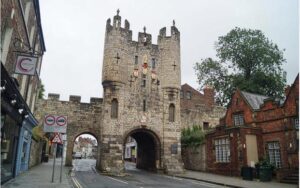The Evolution of York’s City Entrance
York, one of England’s most historic cities, has witnessed dramatic changes over centuries. A striking comparison between its entrance in 1865 and 2015 reveals a fascinating transformation, blending medieval heritage with modern urban development.
1. The Entrance to York in 1865
1.1. A Glimpse into 19th-Century York
In 1865, York’s entrance was a scene of cobbled streets, horse-drawn carriages, and pedestrians navigating through the city’s medieval gates. The imposing stone walls, originally built to defend the city, remained largely untouched, preserving York’s medieval charm.
1.2. The Role of York’s City Walls and Gates
The historic walls and gateways, such as Micklegate Bar and Bootham Bar, served both as defensive structures and checkpoints for traders and travelers entering the city. During this period, York was a bustling market town, deeply connected to its medieval past.

2. Changes in York’s Cityscape by 2015
2.1. Modernization and Urban Expansion
By 2015, York had transformed into a thriving city that seamlessly merged history with contemporary life. The once cobbled roads had been replaced by modern asphalt, and the entrance had adapted to accommodate increasing traffic, including buses, cars, and cyclists.
2.2. Preserving Heritage in a Modern World
Despite these changes, York remained committed to preserving its rich history. Restoration projects ensured that landmarks like Clifford’s Tower, the city walls, and the medieval gateways continued to stand as reminders of York’s past, even as the city embraced modernization.
3. York’s Architectural and Cultural Shift
3.1. The Contrast Between Past and Present
Comparing York’s entrance in 1865 and 2015 highlights the stark contrast between old and new. The once quiet, medieval streets had evolved into vibrant urban pathways, yet the city retained its distinctive character, ensuring that history remained an integral part of its identity.
3.2. The Influence of Tourism and Economy
York’s transformation was also driven by its role as a major tourist destination. The city’s historical significance attracted millions of visitors each year, leading to further development in infrastructure while maintaining strict conservation efforts.

4. The Significance of York’s Transformation
4.1. A Model for Balancing Growth and History
York serves as an excellent example of how a city can embrace progress without losing its historical essence. The careful preservation of its medieval structures alongside urban advancements showcases a successful balance between heritage and modern living.
4.2. What the Future Holds for York
Looking ahead, York continues to evolve while maintaining its historical legacy. Future developments aim to enhance infrastructure and sustainability while protecting its medieval charm, ensuring that generations to come can witness the city’s extraordinary past and promising future.
Conclusion
The transformation of York’s entrance from 1865 to 2015 offers a captivating glimpse into the city’s evolution. From its medieval roots to its modern-day vibrancy, York stands as a testament to the harmonious coexistence of history and progress. Whether viewed through old photographs or experienced in person, York remains a city where the past and present beautifully intertwine.
